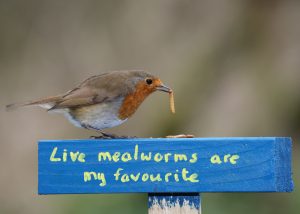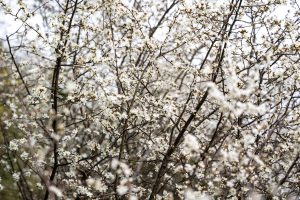Mealworms and more mealworms
If you’re a regular reader of our blog page, then this won’t be the first time you’ve read about live mealworms. In fact, we could be reasonably accused of banging-on about the subject but we make no excuses for that! And the reason being that live mealworms are by far and away the best food you can put out in your garden in the breeding and fledging seasons – which are of course already underway.
So, and for those of you that haven’t fed live mealworms before and don’t know too much about them, here’s a quick lowdown…
Mealworms are the larval form of the mealworm beetle, Tenebrio molitor, which is a species of darkling beetle. So actually mealworms aren’t worms at all, but a larva which, if left to develop, would eventually become a beetle (having turned from larva to pupa first).
[caption id="attachment_729" align="alignleft" width="300"] No caption needed![/caption]
No caption needed![/caption]
There are several points to cover here. Firstly, it’s important to understand the background context that gardens aren’t, typically, great places for birds to find an abundance of natural food. Some of the reasons are obvious such as manicured lawns and areas covered in paving, but it’s also to do with the fact that urban areas are generally far less suitable for many invertebrate species. And even in rural areas invertebrate numbers have decreased due to factors such pesticides, pollution and possibly climate change. So live mealworms are, in effect, a natural food and it’s the ‘natural’ bit which is important here because live mealworms have two things which young birds in the nest and fledglings vitally need: liquid and protein. The liquid element is important because until a bird has fledged it is unable to drink for itself, and remember that all other bird foods – e.g. seed mixes and suet – do not contain liquid. As for protein, well that’s needed for healthy growth and to help ensure that as many of the young birds as possible survive to become adults.
[caption id="attachment_902" align="alignleft" width="300"] This is the ideal sot of feeder for ensuring smaller birds only like Robins and House sparrows can get to the live mealworms[/caption]
This is the ideal sot of feeder for ensuring smaller birds only like Robins and House sparrows can get to the live mealworms[/caption]
You need some sort of bowl or dish, but ideally you should have also a special feeder like this one which keeps larger birds out and ensures that smaller birds like Robins and House Sparrows get their share. So two feeders is the best way – one which all birds can get to and this will be popular with Blackbirds, plus the cage feeder just for smaller birds.
Of course the one thing that puts many people off buying live mealworms and feeding them to their garden birds is the wriggle. But really, you just need to get over it – and most people do and more quickly than they imagine!
So if you haven’t before fed live mealworms to you garden birds, then please, please give it a go. And the very best reason for doing so is the difference it can make to the breeding success of your local birds. A great example of which is one of our customers who roughly trebled the population of House Sparrows in his area over a four year period as a direct result of feeding live mealworms throughout the breeding and fledging seasons.
So, and for those of you that haven’t fed live mealworms before and don’t know too much about them, here’s a quick lowdown…
What are mealworms?
Mealworms are the larval form of the mealworm beetle, Tenebrio molitor, which is a species of darkling beetle. So actually mealworms aren’t worms at all, but a larva which, if left to develop, would eventually become a beetle (having turned from larva to pupa first).
[caption id="attachment_729" align="alignleft" width="300"]
 No caption needed![/caption]
No caption needed![/caption]Why are live mealworms so good for garden birds?
There are several points to cover here. Firstly, it’s important to understand the background context that gardens aren’t, typically, great places for birds to find an abundance of natural food. Some of the reasons are obvious such as manicured lawns and areas covered in paving, but it’s also to do with the fact that urban areas are generally far less suitable for many invertebrate species. And even in rural areas invertebrate numbers have decreased due to factors such pesticides, pollution and possibly climate change. So live mealworms are, in effect, a natural food and it’s the ‘natural’ bit which is important here because live mealworms have two things which young birds in the nest and fledglings vitally need: liquid and protein. The liquid element is important because until a bird has fledged it is unable to drink for itself, and remember that all other bird foods – e.g. seed mixes and suet – do not contain liquid. As for protein, well that’s needed for healthy growth and to help ensure that as many of the young birds as possible survive to become adults.
How do you feed live mealworms?
[caption id="attachment_902" align="alignleft" width="300"]
 This is the ideal sot of feeder for ensuring smaller birds only like Robins and House sparrows can get to the live mealworms[/caption]
This is the ideal sot of feeder for ensuring smaller birds only like Robins and House sparrows can get to the live mealworms[/caption]You need some sort of bowl or dish, but ideally you should have also a special feeder like this one which keeps larger birds out and ensures that smaller birds like Robins and House Sparrows get their share. So two feeders is the best way – one which all birds can get to and this will be popular with Blackbirds, plus the cage feeder just for smaller birds.
Of course the one thing that puts many people off buying live mealworms and feeding them to their garden birds is the wriggle. But really, you just need to get over it – and most people do and more quickly than they imagine!
So if you haven’t before fed live mealworms to you garden birds, then please, please give it a go. And the very best reason for doing so is the difference it can make to the breeding success of your local birds. A great example of which is one of our customers who roughly trebled the population of House Sparrows in his area over a four year period as a direct result of feeding live mealworms throughout the breeding and fledging seasons.


